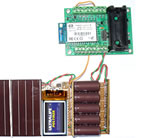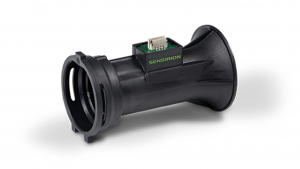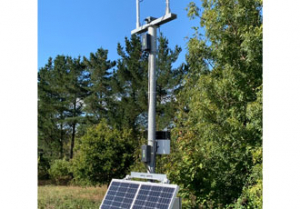Solar-powered Cloud Instrument™ sends data to real-time data-brokerage platform
4th June 2010
Source:
Adept Scientific plc

A recent application of the Cores Electronic Tag4M sensor tag, available from Adept Scientific illustrates two new uses for this credit-card sized device which delivers its data directly to a targeted website through any commercially available access point or wireless router.
The application proves the ability to run this low-power WiFi sensor tag from solar power and deliver readings to Pachube. Pachube (www.pachube.com/feeds/7277) has emerged as one of the leading public web applications that enables people to share real time sensor data from objects, devices and spaces around the World.
This is just one combination of data-collection hardware and remote analysis/display software that utilises the Instrumentation Cloud, which gets its name because users can read and control a sensor tag from anywhere in the World using any web-enabled device from a PC to an iPhone.
Solar-cell powered WiFi tag
In some applications it is desirable to have the Tag4M tag powered by a solar cell in continuous operation. In creating a setup, you must ask questions regarding the solar cell’s ability to store energy during the day to allow for use at night and its capability to supply enough current for Wi-Fi communication sessions. In addition, the solar-power scheme’s overall size, complexity and cost must be sufficiently low to make it cost competitive with batteries.
Dr S Folea at the Automation Department at the Technical University of Cluj-Napoca, Romania, researched the best way to meet the requirements of a sensor tag located in non-optimum lighting conditions but that nevertheless must provide data 24 hours a day. His design takes into consideration the power needed during the tag’s boot sequence, transmission period, measurement period and receiving period; the peak current required at any time is 210 mA and the unit operates from 2V to 3.7V dc. His final design powers the Tag4M from a solar cell connected to a capacitor array through a buck-boost converter, all augmented with a rechargeable lithium ion accumulator and a charger.
Read data values over the web
This setup is more than a theoretical concept; it provides real-time feeds of temperature, pressure and humidity data as well as key system parameters on the tag itself including solar-cell voltage and sleep time through the Pachube website. While Cores Electronic, the Tag4M’s developer, provides the Tag4M Web Page Instrument which allows designers to create their own Web Page Instruments that accept and display sensor tag information, public services such as Pachube are becoming increasingly popular as an alternative to developing a Web Page Instrument.
In order to send sensor data to Pachube, you must bundle it into a script written in EEML (Extended Environments Markup Language), a protocol for sharing sensor data between remote responsive environments, both physical and virtual. In this case, an application running on a local PC reads sensor data from Tag4M over a wireless link, bundles the data into an EEML script in a format Pachube understands and sends it using TCP/IP Write commands to the Internet and the Pachube website.
Finally, the Pachube website captures the data and posts it on a feed that is visible to anyone who logs onto that particular web page. To eliminate the PC in this process, Cores Electronic is developing a special Tag4M Pachube Version whose onboard processor will create the EEML script and send this feed through an access point directly to the Pachube website for display.
The current solar-based combination is an excellent example of the Instrumentation Cloud whereby sensors send their readings directly into the Internet. Users anywhere in the World can examine them and, if the setup allows it, send commands to digital I/O on the sensor tag. In this case, the experiment is running in Cluj-Napoca, Romania, the web page is hosted in London and users with a web browser anywhere in the World can access it.
The hardware element upon which this application is based is the Tag4M from Cores Electronic. Because it leverages RFID technology this small, credit-card sized measurement board, also called a WiFi tag, contains everything needed for true remote standalone operation. It starts with a WiFi radio chip that communicates with a nearby wireless access point, provides measurement circuitry including an A/D and digital I/O, and its CPU controls the operations of those subsystems as well as executes user measurement and control scripts. In addition, extremely low power consumption means that, depending on the frequency of wake-up periods, a tag can operate on a small battery or even from solar power.
This is just one combination of data-collection hardware and remote analysis/display software that utilises the Instrumentation Cloud, which gets its name because users can read and control a sensor tag from anywhere in the World using any web-enabled device from a PC to an iPhone.
Solar-cell powered WiFi tag
In some applications it is desirable to have the Tag4M tag powered by a solar cell in continuous operation. In creating a setup, you must ask questions regarding the solar cell’s ability to store energy during the day to allow for use at night and its capability to supply enough current for Wi-Fi communication sessions. In addition, the solar-power scheme’s overall size, complexity and cost must be sufficiently low to make it cost competitive with batteries.
Dr S Folea at the Automation Department at the Technical University of Cluj-Napoca, Romania, researched the best way to meet the requirements of a sensor tag located in non-optimum lighting conditions but that nevertheless must provide data 24 hours a day. His design takes into consideration the power needed during the tag’s boot sequence, transmission period, measurement period and receiving period; the peak current required at any time is 210 mA and the unit operates from 2V to 3.7V dc. His final design powers the Tag4M from a solar cell connected to a capacitor array through a buck-boost converter, all augmented with a rechargeable lithium ion accumulator and a charger.
Read data values over the web
This setup is more than a theoretical concept; it provides real-time feeds of temperature, pressure and humidity data as well as key system parameters on the tag itself including solar-cell voltage and sleep time through the Pachube website. While Cores Electronic, the Tag4M’s developer, provides the Tag4M Web Page Instrument which allows designers to create their own Web Page Instruments that accept and display sensor tag information, public services such as Pachube are becoming increasingly popular as an alternative to developing a Web Page Instrument.
In order to send sensor data to Pachube, you must bundle it into a script written in EEML (Extended Environments Markup Language), a protocol for sharing sensor data between remote responsive environments, both physical and virtual. In this case, an application running on a local PC reads sensor data from Tag4M over a wireless link, bundles the data into an EEML script in a format Pachube understands and sends it using TCP/IP Write commands to the Internet and the Pachube website.
Finally, the Pachube website captures the data and posts it on a feed that is visible to anyone who logs onto that particular web page. To eliminate the PC in this process, Cores Electronic is developing a special Tag4M Pachube Version whose onboard processor will create the EEML script and send this feed through an access point directly to the Pachube website for display.
The current solar-based combination is an excellent example of the Instrumentation Cloud whereby sensors send their readings directly into the Internet. Users anywhere in the World can examine them and, if the setup allows it, send commands to digital I/O on the sensor tag. In this case, the experiment is running in Cluj-Napoca, Romania, the web page is hosted in London and users with a web browser anywhere in the World can access it.
The hardware element upon which this application is based is the Tag4M from Cores Electronic. Because it leverages RFID technology this small, credit-card sized measurement board, also called a WiFi tag, contains everything needed for true remote standalone operation. It starts with a WiFi radio chip that communicates with a nearby wireless access point, provides measurement circuitry including an A/D and digital I/O, and its CPU controls the operations of those subsystems as well as executes user measurement and control scripts. In addition, extremely low power consumption means that, depending on the frequency of wake-up periods, a tag can operate on a small battery or even from solar power.
Similar articles
More from Adept Scientific plc
- An exciting new add-on had been added to Maplesoft’s™ MapleSim™ 4th August 2011
- Adept Scientific continues to broaden its data acquisition range 5th July 2011
- Latest MapleSim release opens new avenues for model development 16th June 2011
- New task-based, document-centric calculations environment improves personal and engineering process productivity. 25th January 2011












Write a comment
No comments